By Peter Darnall
Any of the racing Alfa Romeos from the decade of the 1930s will fetch a king’s ransom in today’s collector market. Put a Tipo C on the block and the opening bids would normally be associated with high-end real estate properties. When the rarest of them all, a 1935 8C-35 with matching engine and chassis number 50013, was offered by Bonhams in 2013, the winning bid was the highest price ever paid for a single seat racer!
The Tipo C Alfa Romeo was the Italian answer to the Teutonic blitzkrieg waged by Mercedes Benz and Auto Union on the Grand Prix circuits of Europe. Although usually rated an underdog to the government-subsidized German juggernauts, these Alfas could hold their own on a tight winding circuit.
In 1936, Scuderia Ferrari brought four Tipo C Alfa Romeos, two 8-cylinder and two 12-cylinder machines, to contest the Coppa Ciano event, which would be held on the tricky Montenero circuit at Livorno. Mercedes Benz had elected to bypass this race, but the Auto Union team turned out in force with three cars. Tazio Nuvolari’s 12-cylinder Alfa succumbed to driveline failure seconds after the start, forcing the frustrated Italian to walk back to the pits for a replacement car. Carlo Pintacuda’s 8-cylinder machine was brought in and turned over to Nuvolari, who rejoined the race far behind the Auto Unions. Driving a car which had been set up for the larger Pintacuda, the diminutive Italian put on a virtuoso display of high-speed driving on the narrow winding streets that had the partisan Italian spectators on their feet wildly waving and cheering him on.
The Alfas dominated the last third of that race with the “Flying Mantuan” winning and giving the Scuderia a clean sweep of the first three positions. Hans Stuck, who had taken over Bernd Rosemeyer’s Auto Union, finished in 4th place, more than three minutes behind the winning Alfa. During the summer of 1936, Nuvolari was at the top of his form, beating the German teams four times within two months (Penya Rhin, Milan, Budapest and Coppa Ciano).
And that Tipo C which Nuvolari drove at to victory in the Coppa Ciano might well have been Number 50013! Although both Autocar and Speed magazines of the day carried
articles claiming such, Scuderia Ferrari records do not document which 8-cylinder Tipo C had been assigned to Carlo Pintacuda and subsequently turned over to Nuvolari.
We do know that Hans Ruesch purchased Alfa Romeo 8C-35 #50013 from Scuderia Ferrari in September,1936. The story of Hans Ruesch and his successes campaigning the Alfa have previously been described in VeloceToday (Hans Ruesch: The Man, His Books, a Hollywood Movie, and an Alfa Romeo 8C-35). In 1939, Ruesch sold the car to Robert Arbuthnot, an Alfa enthusiast and proprietor of High Speed Motors located in Lancaster Mews in London. Arbuthnot had a brief moment of glory with #50013 during the August Bank Holiday meeting at Brooklands when he set a new Class C record for the road course and was leading the field in the ten lap Campbell Trophy race before a wild spin dropped him to the back of the field.
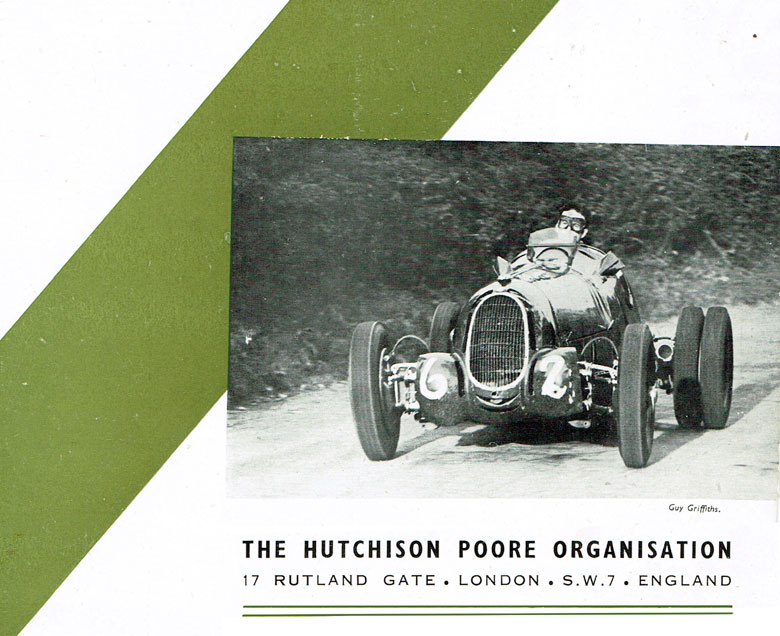
Dramatic Guy Griffiths photo featured in a Hutchison Poore Organization promotional brochure. Note the dual rear wheel setup on the Alfa. Copies of brochure supplied by Peter Giddings Collection.
That event would be the last race held at the Weybridge facility before the outbreak of war on September 3, 1939, ended all automobile racing. The Alfa was put into storage and Arbuthnot planned to resume his racing ambitions when sanity returned. Although he survived the war years, Arbuthnot sadly lost his life in an automobile road accident on August 1946. The title to the Alfa, which had been pledged as collateral on a loan, transferred to the new owner Dennis Poore. Poore thus became the owner of a pukka Grand Prix Alfa Romeo by default; there was only one sensible option–and that was to drive it!
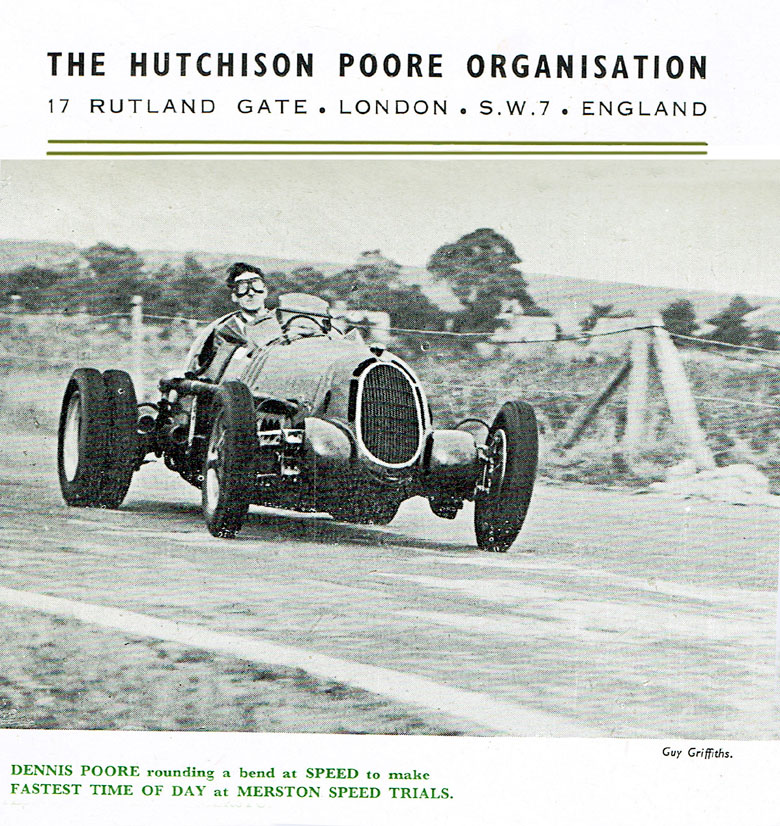
Another Guy Griffiths photograph of the Alfa at speed with original caption from the Hutchison Poore Organization promotional brochure. Courtesy of the Peter Giddings Collection.
Although Poore had had considerable success campaigning a supercharged MG J4 Midget previously raced by Hugh Hamilton, the mechanical complexities of the Alfa marred the initial outings. The following year was a different story: Bill Lawes had joined Poore’s entourage and put his RAF experience to good use. With occasional assistance from Sten “Tammy” Aberg, Lawes soon had the Alfa running reliably. The Alfa, now decked out in British Racing Green livery, soon became a top contender on the racing venues. A white Pegasus winged horse figure, the insignia of the newly formed Hutchison Poore Organization, replaced the Scuderia Ferrari prancing horse.
Austerity in post-war Britain had resulted in fuel rationing and limitations on motor racing events. Brooklands, Donington, and the original Crystal Palace venues were no longer available. Therefore, in 1947, the RAC had decided to run a national hill climb championship with events to be held at Bo’ness, Shelsley Walsh, Bouley Bay, Craigantlet and Prescott.
If the Alfa were to be competitive on the hills, Poore realized that modifications would have to be made. The standard Alfa gearbox was not strong enough for full-throttle standing starts so a special Wilson-E.N.V. preselector unit was acquired. This gearbox was one of two in existence, having been constructed as a spare for the Barnato-Hassan Brooklands machine. Since the Tipo C gearbox was incorporated with the differential, the original transaxle assembly was left intact and the new Wilson unit was mounted between it and the engine. All shifting was to be performed by the preselector unit while the transaxle mechanism would be locked in whatever final drive ratio best suited the event.
The original Alfa Romeo roots-type superchargers were replaced with Wade aeronautical RO-15 cabin blowers, which increased the charge from 5-6 psi to 8-10 psi. A circular inlet port manifold system, which was copied from Chris Staniland’s iconic Multi-Union race car, was fitted. Apart from the increased boost, the engine modifications were incorporated to allow the car to run on a 100% methanol fuel as opposed to the original 90%/10% methanol/gasoline mixture.
Transmitting this power to the road was addressed by fabricating a twin rear wheel setup which resulted in a strong understeering tendency. In a 1952 interview, Dennis Poore described the handling of the Alfa at speed: “It had very substantial understeer on the standard (17-inch) wheels and it was necessary to tuck over well before corners.” On one occasion at Boreham, he tried 19-inch wheels but nearly rolled the Alfa as a result. Asked about the likelihood of spinning, he replied that he did not think it would.
The British specialist motoring press followed the Alfa closely; almost every weekend featured coverage of the Poore Alfa at various venues. Sharing the spotlight with the Alfa was a distinctive Dodge tow truck that had been purchased as war surplus and customized by the Hutchison Poore Organization to prominently display the winged Pegasus figure and incorporate the suppliers’ logos.
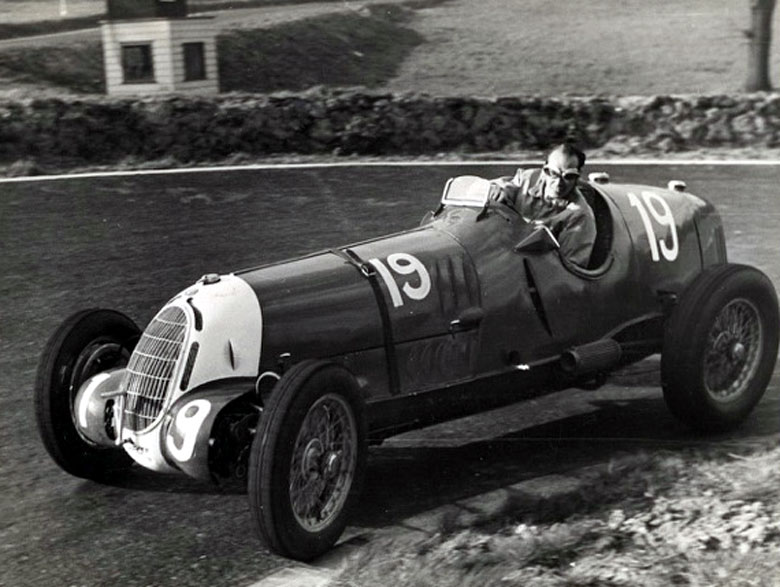
Poore in the Alfa, date and location unknown. Photo from the collection of Dale Lafollette, photographer unknown.
In those halcyon days before safety concerns required the wearing of crash helmets, photographs of Dennis in the Alfa showed him driving as he preferred, bare headed with hair blowing in the wind. And he was fast . . .
“You might say Dennis was ‘blindingly’ fast,” quipped Peter Giddings, a subsequent owner of the Alfa. After a moment’s pause, he added that Dennis suffered from impaired vision and that he went to great lengths to hide this condition from the motor racing authorities. “He was practically blind. I can’t imagine how he managed to cope with that Alfa’s power and tricky handling—but he certainly did!”
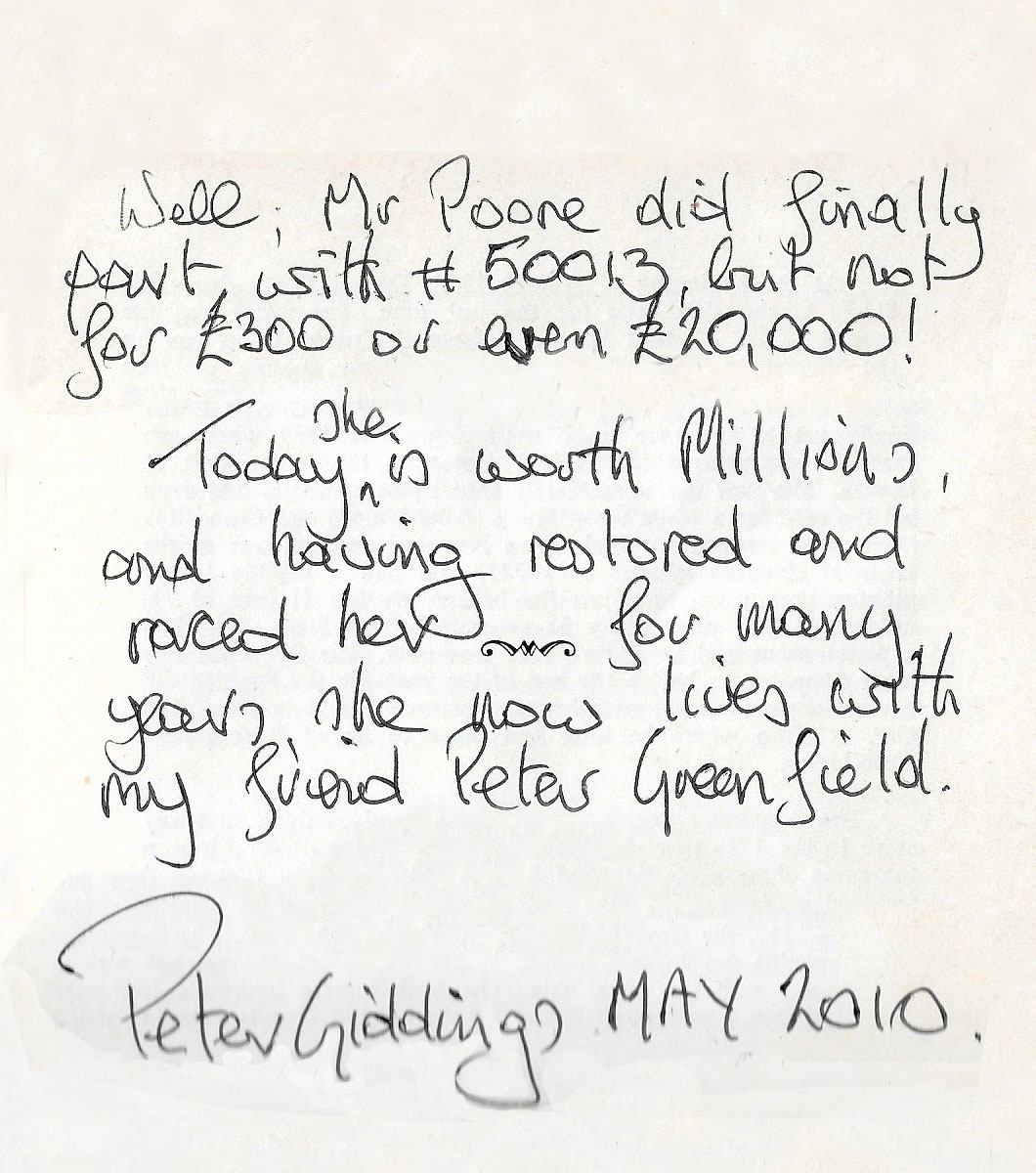
A note Peter Giddings wrote to the author relating to his thoughts on the ownership of the Alfa. In 1995 Peter Giddings acquired 50013, had it restored and campaigned it all over the world, finally parting with it to Peter Greenfield in 2005.
Following the high point of the Hillclimb Championship in 1950, Poore had moments of glory with the Alfa, but business interests and driving commitments with modern Connaught and Aston Martin race cars eventually sidelined his privateering efforts with the Alfa. The Alfa was put into storage, first at Southhampton and later at Maidenhead.
Business interests had caused Poore to retire from racing, but he never sold the Alfa. Biographer Michael Lindsay recorded that Poore once remarked that he did not know why he kept the Alfa, but it was obviously special to him. In 1973, Poore was offered £300 for the car and nearly took it, and later he would turn down an offer in the region of £20,000!
The Alfa remained in storage until Poore’s death at the age of 70 in 1987. His executors consigned it to Christie’s, and it was sold at the Monaco auction in 1988 to Anthony Mayman for (US) $2,850,000.
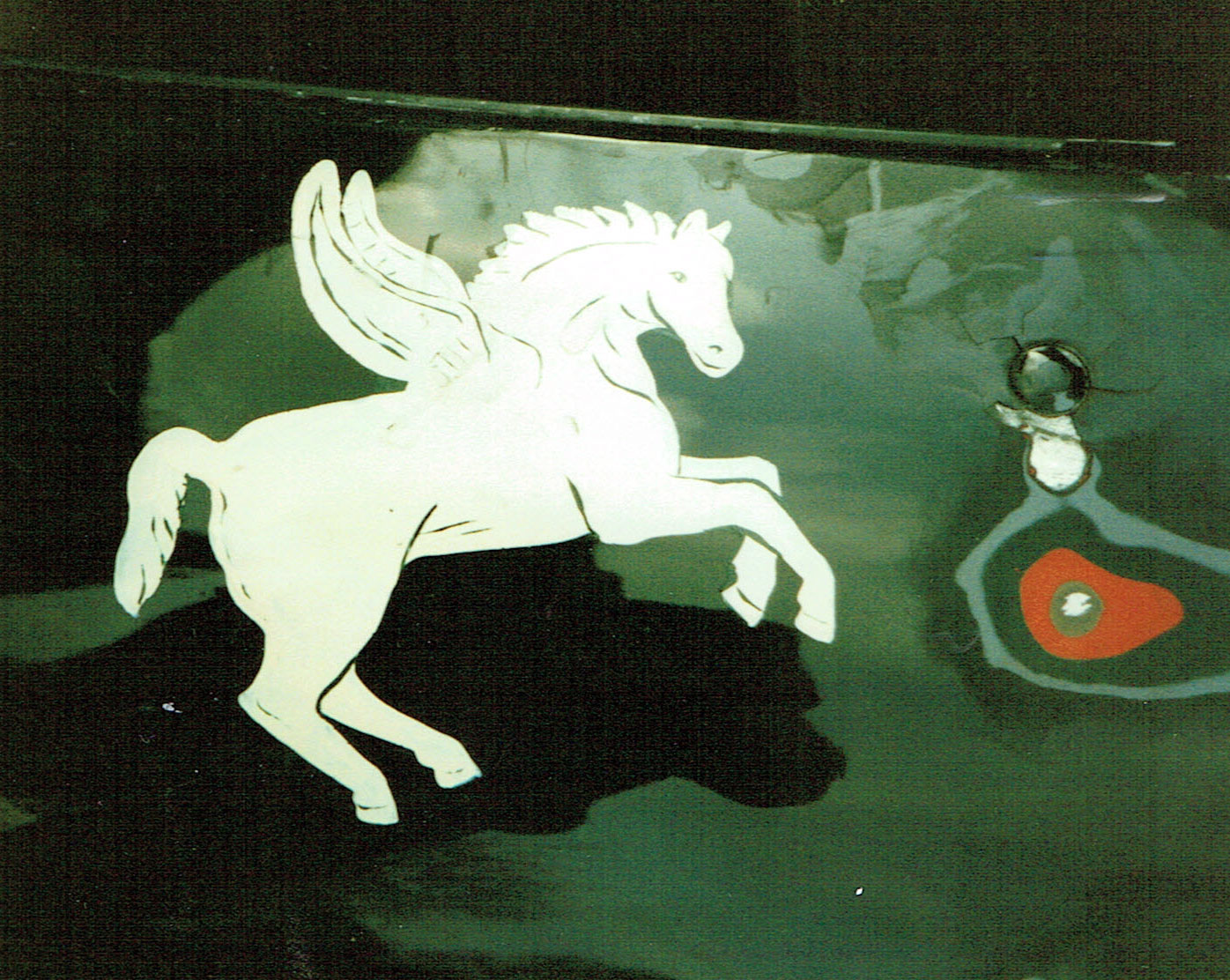
Photograph taken during 2011 restoration by Paul Grist documents original hand painted white Pegasus figure with areas of green Valspar, gray undercoats, and swatch of original Ferrari dark red color. Photograph Courtesy of the Peter Giddings Collection
The below youtube video is specific to chassis 50013 and very much worth watching!!!
And more…
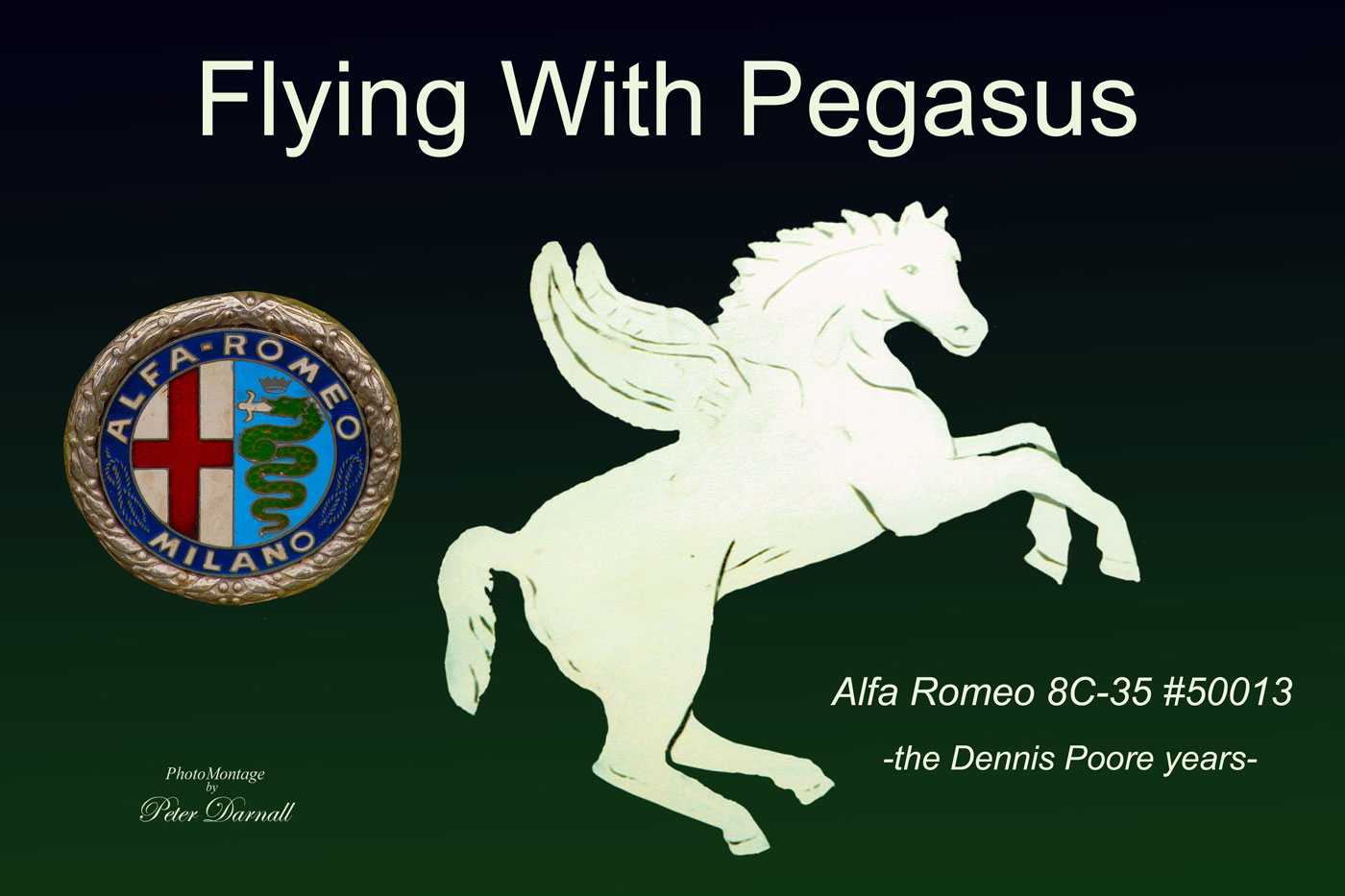
Great stuff as always, Peter. I am reminded of a comment about Douglas Hull, quoted in his brother Peter’s wonderful book “Racing An Historic Car”; “If Douglas Hull was 20 years younger and could see past the end of the bonnet, he’d be a good racing driver”.